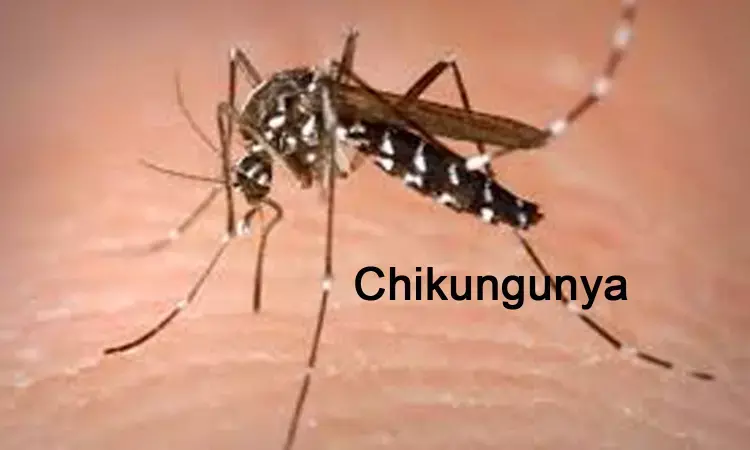- Home
- Medical news & Guidelines
- Anesthesiology
- Cardiology and CTVS
- Critical Care
- Dentistry
- Dermatology
- Diabetes and Endocrinology
- ENT
- Gastroenterology
- Medicine
- Nephrology
- Neurology
- Obstretics-Gynaecology
- Oncology
- Ophthalmology
- Orthopaedics
- Pediatrics-Neonatology
- Psychiatry
- Pulmonology
- Radiology
- Surgery
- Urology
- Laboratory Medicine
- Diet
- Nursing
- Paramedical
- Physiotherapy
- Health news
- Fact Check
- Bone Health Fact Check
- Brain Health Fact Check
- Cancer Related Fact Check
- Child Care Fact Check
- Dental and oral health fact check
- Diabetes and metabolic health fact check
- Diet and Nutrition Fact Check
- Eye and ENT Care Fact Check
- Fitness fact check
- Gut health fact check
- Heart health fact check
- Kidney health fact check
- Medical education fact check
- Men's health fact check
- Respiratory fact check
- Skin and hair care fact check
- Vaccine and Immunization fact check
- Women's health fact check
- AYUSH
- State News
- Andaman and Nicobar Islands
- Andhra Pradesh
- Arunachal Pradesh
- Assam
- Bihar
- Chandigarh
- Chattisgarh
- Dadra and Nagar Haveli
- Daman and Diu
- Delhi
- Goa
- Gujarat
- Haryana
- Himachal Pradesh
- Jammu & Kashmir
- Jharkhand
- Karnataka
- Kerala
- Ladakh
- Lakshadweep
- Madhya Pradesh
- Maharashtra
- Manipur
- Meghalaya
- Mizoram
- Nagaland
- Odisha
- Puducherry
- Punjab
- Rajasthan
- Sikkim
- Tamil Nadu
- Telangana
- Tripura
- Uttar Pradesh
- Uttrakhand
- West Bengal
- Medical Education
- Industry
MRI Brain Findings may Help Detect Chikungunya Encephalitis during Chikungunya Epidemic

The role of MRI in patients presenting with neurological symptoms to diagnose Chikungunya encephalitis, especially in epidemic settings, was recently studied by researchers of BL Kapoor hospital Delhi, and they have found that detection of focal or confluent white matter hyper-intense foci with restricted diffusion on MRI in patients presenting with fever and neurological symptoms has potential to conclude the diagnosis of Chikungunya encephalitis, especially in epidemic settings.
Chikungunya is an arboviral disease which is transmitted by the Aedes mosquito. The Chikungunya virus (CHIKV) is an alphavirus RNA of the family Togaviridae and genus Alphavirus. The mode of transmission from primates to humans is via the Aedes Aegypti mosquito.Its first outbreak was during an epidemic in East Africa between 1952 and1953.
In India, CHIKV was first detected in 1963 in West Bengal, followed by several epidemics between 1964 and 1973 and the last one in 2005 and 2016, which affected several Indian states. In 2016, North India observed a massive outbreak.
CHIKV is a disease of self-limiting illness, and neurological complications are rare. However, it is not clear whether these complications are because of virus or immune response.
Frequently described neurological syndromes include encephalopathy, encephalitis, myelopathy, myelitis, Guillain-Barre syndrome, and neonatal hypotonia. Less frequently described features include sensorineural hearing loss, behavioral changes, and meningism.
It has not been fully understood/elucidated how CHIKV affects CNS. It can act directly by targeting neurons or indirectly by triggering immune-mediated effects through up-regulation of anti-viral and inflammatory cytokines.
This study by Sergei et al shows predominantly discrete and confluent supra-tentorial T2W and FLAIR hyper-intense white matter foci in 27 patients (63%), and restricted diffusion seen on DWI in 14 patients (33%). Restricted diffusion in frontoparietal white matter was described as an early sign of viral encephalitis. Restricted diffusion is because of cytotoxic edema, secondary to plasma leakage from capillaries and venules associated with immune-mediated allergic peri-vascular de-myelination.
Cytotoxic lesion that shows restricted diffusion was seen in the splenium of the corpus callosum in one patient. One of the theories suggests that cells of the corpus callosum have a higher density of cytokine, glutamate, and other excitatory amino acid receptors, compared with other brain areas, resulting in a tendency for developing cytotoxic edema. However, this finding is not specific for CHIKV and seen in patients with other infections such as Staphylococcus aureus, Legionella, and hemolytic uremic syndrome and gastro-intestinal infections caused by E. coli, Salmonella, or rotavirus.
MRI in three pediatric patients including two neonates in our study had a diffuse pattern of white matter involvement with restricted diffusion. Hemorrhage in supra-tentorial white matter was seen in one of the pediatric patients.
These findings occur in the acute phase. In the sub-acute phase, areas of low signal intensity are related to vasogenic edema, and in the chronic phase, the lesions show cavitations and parenchymal atrophy. The main differentials for neonatal CHIKV infection during the acute phase are parechovirus and rotavirus infections which are excluded by laboratory tests.
“The detection of focal or confluent white matter hyper-intense foci with restricted diffusion on MRI in patients presenting with fever and neurological symptoms has potential to conclude the diagnosis of Chikungunya encephalitis, especially in epidemic settings”, conclude the authors.
Reference
Magnetic Resonance Imaging Brain Findings in Chikungunya Virus (CHIKV) Infection with Neurological Complication during Epidemic Outbreak, Sethi Kanika Sekhri, Aryan Abhay Kumar, Ganeshan Prem Kumar, Neurology India Year : 2023 | Volume: 71 | Issue Number: 3 | Page: 467-470 DOI: 10.4103/0028-3886.378660
MBBS, DrNB Neurosurgery
Krishna Shah, MBBS, DrNB Neurosurgery. She did her MBBS from GMC, Jamnagar, and there after did direct 6 Year DrNB Neurosurgery from Sir Ganga Ram Hospital, Delhi. Her interests lie in Brain and Spine surgery, Neurological disorders, minimally invasive surgeries, Endoscopic brain and spine procedures, as well as research.
Dr Kamal Kant Kohli-MBBS, DTCD- a chest specialist with more than 30 years of practice and a flair for writing clinical articles, Dr Kamal Kant Kohli joined Medical Dialogues as a Chief Editor of Medical News. Besides writing articles, as an editor, he proofreads and verifies all the medical content published on Medical Dialogues including those coming from journals, studies,medical conferences,guidelines etc. Email: drkohli@medicaldialogues.in. Contact no. 011-43720751


